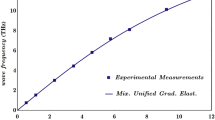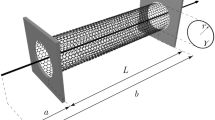Abstract
A naturally discrete nanobar implies that the continuum axiom is failed, and its surface-to-volume ratio is very large. The nonlocal theory of elasticity releasing the continuum axiom and the surface theory of elasticity are therefore employed to model tensile nanobars in this work. As commonly believed in the current practice, the axial nonlocal effect is only taken in account to analyze the mechanical behaviors of nanobars, regardless of their three-dimensional inherent atomistic interactions. In this study, a three-dimensional nonlocal constitutive law is developed to model the true nonlocal effect of nanobars, and based on which, a self-consistent variational bar model is proposed. It has been revealed for the first time how both the cross-sectional nonlocal interactions and the axial nonlocality affect the tensile behaviors of nanobars. It is found that the nonlocal influence predicted by the currently axial nonlocal bar model is grossly underestimated. Both the nonlocal cross-sectional and axial interactions become significant when the length-to-height ratio of nanobars is small. If the length-to-height ratio is relatively large (slender bars), the main nonlocal effect stems, however, from the nonlocal cross-sectional effect, rather than the axial nonlocal effect. This work also shows that it is possible to overcome the ill-posed problem of the pure nonlocal integral elasticity by employing both the pure nonlocal integral elasticity and surface elasticity. A well-posed size-dependent governing equation has been established for modeling nanobars under tension, and closed-form solutions are derived for their displacements. Based on the closed-form solutions, the effective elastic modulus is obtained and will be useful for calibrating the physical quantities in the “discretecontinuum” transition region for a span-scale modeling approach. It is shown that the effective elastic modulus may be softening or hardening, depending on the competition between the surface (modulus-hardening) and nonlocal (modulus-softening) effects.
Similar content being viewed by others
References
Cowley E R. Lattice dynamics of silicon with empirical many-body potentials. Phys Rev Lett, 1988, 60: 2379–2381
Yakobson B I, Brabec C J, Bernholc J. Nanomechanics of carbon tubes: Instabilities beyond linear response. Phys Rev Lett, 1996, 76: 2511-2514
Admal N C, Tadmor E B. A Unified interpretation of stress in molecular systems. J Elast, 2010, 100: 63–143
Duan K, He Y, Li Y, et al. Machine-learning assisted coarse-grained model for epoxies over wide ranges of temperatures and cross-linking degrees. Mater Design, 2019, 183: 108130
Li L, Lin R, Ng T Y. A fractional nonlocal time-space viscoelasticity theory and its applications in structural dynamics. Appl Math Model, 2020, 84: 116–136
Eringen A C. Nonlocal Continuum Field Theories. New York: Springer Science & Business Media, 2002
Aydogdu M. Axial vibration of the nanorods with the nonlocal continuum rod model. Physica E-Low-dimensional Syst NanoStruct, 2009, 41: 861–864
Adhikari S, Murmu T, McCarthy M A. Frequency domain analysis of nonlocal rods embedded in an elastic medium. Physica E-Lowdimensional Syst NanoStruct, 2014, 59: 33–40
Li L, Hu Y, Li X. Longitudinal vibration of size-dependent rods via nonlocal strain gradient theory. Inter J Mech Sci, 2016, 115: 135–144
Angela Pisano A, Fuschi P. Closed form solution for a nonlocal elastic bar in tension. Int J Solids Struct, 2003, 40: 13–23
Zhu X, Li L. Closed form solution for a nonlocal strain gradient rod in tension. Int J Eng Sci, 2017, 119: 16–28
Zhu X, Li L. Longitudinal and torsional vibrations of size-dependent rods via nonlocal integral elasticity. Int J Mech Sci, 2017, 133: 639–650
Zhu X, Li L. On longitudinal dynamics of nanorods. Int J Eng Sci, 2017, 120: 129–145
Faghidian S A, Mohammad-Sedighi H. Dynamics of nonlocal thick nano-bars. Eng Comput, 2020, doi: https://doi.org/10.1007/s00366-020-01216-3
Li L, Lin R, Hu Y. Cross-section effect on mechanics of nonlocal beams. Archive Appl Mech, 2021, 91: 1541–1556
Eringen A C. On differential equations of nonlocal elasticity and solutions of screw dislocation and surface waves. J Appl Phys, 1983, 54: 4703–4710
Uzun B, Kafkas U, Yaylı M Ö. Axial dynamic analysis of a bishop nanorod with arbitrary boundary conditions. ZAMM-Journal of Applied Mathematics and Mechanics/Zeitschrift für Angewandte Mathematik und Mechanik, 2020, 100: e202000039
Reddy J N. Nonlocal theories for bending, buckling and vibration of beams. Int J Eng Sci, 2007, 45: 288–307
Li L, Hu Y. Buckling analysis of size-dependent nonlinear beams based on a nonlocal strain gradient theory. Int J Eng Sci, 2015, 97: 84–94
Wu H, Liu H. Nonlinear thermo-mechanical response of temperaturedependent FG sandwich nanobeams with geometric imperfection. Eng Comput, 2020, doi: https://doi.org/10.1007/s00366-020-01005-y
Ghayesh M H, Farajpour A. Nonlinear coupled mechanics of nanotubes incorporating both nonlocal and strain gradient effects. Mech Adv Mater Struct, 2020, 27: 373–382
Civalek Ö, Uzun B, Yaylı M Ö, et al. Size-dependent transverse and longitudinal vibrations of embedded carbon and silica carbide nanotubes by nonlocal finite element method. Eur Phys J Plus, 2020, 135: 381
Tang H, Li L, Hu Y. Coupling effect of thickness and shear deformation on size-dependent bending of micro/nano-scale porous beams. Appl Math Model, 2019, 66: 527–547
Shahraki H, Tajmir Riahi H, Izadinia M, et al. Buckling and vibration analysis of FG-CNT-reinforced composite rectangular thick nanoplates resting on Kerr foundation based on nonlocal strain gradient theory. J Vib Control, 2020, 26: 277–305
Karami B, Shahsavari D, Janghorban M, et al. On the resonance of functionally graded nanoplates using bi-Helmholtz nonlocal strain gradient theory. Int J Eng Sci, 2019, 144: 103143
Karami B, Janghorban M. On the mechanics of functionally graded nanoshells. Int J Eng Sci, 2020, 153: 103309
Xu X, Karami B, Janghorban M. On the dynamics of nanoshells. Int J Eng Sci, 2021, 158: 103431
Gurtin M E, Ian Murdoch A. Surface stress in solids. Int J Solids Struct, 1978, 14: 431–440
Steigmann D J, Ogden RW. Elastic surface substrate interactions. Proceed R Soc London Ser A, 1999, 455: 437–474
Gao X, Huang Z, Qu J, et al. A curvature-dependent interfacial energybased interface stress theory and its applications to nano-structured materials: (I) General theory. J Mech Phys Solids, 2014, 66: 59–77
He J, Lilley C M. Surface effect on the elastic behavior of static bending nanowires. Nano Lett, 2008, 8: 1798–1802
Eremeyev V A. On effective properties of materials at the nano- and microscales considering surface effects. Acta Mech, 2016, 227: 29–42
Duan H L, Wang J X, Karihaloo B L. Theory of elasticity at the nanoscale. Adv Appl Mech, 2009, 42: 1–68
Kiani K. Free dynamic analysis of functionally graded tapered nanorods via a newly developed nonlocal surface energy-based integrodifferential model. Composite Struct, 2016, 139: 151–166
Kiani K, Żur K K. Vibrations of double-nanorod-systems with defects using nonlocal-integral-surface energy-based formulations. Composite Struct, 2021, 256: 113028
Yuan Y, Xu K, Kiani K. Torsional vibration of nonprismatically nonhomogeneous nanowires with multiple defects: Surface energy-nonlocalintegro-based formulations. Appl Math Model, 2020, 82: 17–44
Kiani K, Żur K K. Dynamic behavior of magnetically affected rod-like nanostructures with multiple defects via nonlocal-integral/differentialbased models. Nanomaterials, 2020, 10: 2306
Li L, Lin R, Ng T Y. Contribution of nonlocality to surface elasticity. Int J Eng Sci, 2020, 152: 103311
Ruzsicska B P, Jodhan A, Choi H K J, et al. Chemistry of carbynes: Reaction of CF, CCl, and CBr with alkenes. J Am Chem Soc, 1983, 105: 2489–2490
Zhu X, Li L. Twisting statics of functionally graded nanotubes using Eringen’s nonlocal integral model. Composite Struct, 2017, 178: 87–96
Bažant Z P, Jirásek M. Nonlocal integral formulations of plasticity and damage: Survey of progress. J Eng Mech, 2002, 128: 1119–1149
Srinivasa A R, Reddy J N. An overview of theories of continuum mechanics with nonlocal elastic response and a general framework for conservative and dissipative systems. Appl Mech Rev, 2017, 69: 030802
Kiani K. Nonlocal-integro-differential modeling of vibration of elastically supported nanorods. Physica E-Low-dimensional Syst NanoStruct, 2016, 83: 151–163
Fernández-Sáez J, Zaera R, Loya J A, et al. Bending of Euler-Bernoulli beams using Eringen’s integral formulation: A paradox resolved. Int J Eng Sci, 2016, 99: 107–116
Eringen A C. Linear theory of nonlocal elasticity and dispersion of plane waves. Int J Eng Sci, 1972, 10: 425–435
Farajpour A, Howard C Q, Robertson W S P. On size-dependent mechanics of nanoplates. Int J Eng Sci, 2020, 156: 103368
Darban H, Luciano R, Caporale A, et al. Higher modes of buckling in shear deformable nanobeams. Int J Eng Sci, 2020, 154: 103338
Barretta R, Faghidian S A, de Sciarra F M. A consistent variational formulation of bishop nonlocal rods. Contin Mech Thermodyn, 2020, 32: 1311–1323
Benvenuti E, Simone A. One-dimensional nonlocal and gradient elasticity: Closed-form solution and size effect. Mech Res Commun, 2013, 48: 46–51
Wang Y B, Zhu X W, Dai H H. Exact solutions for the static bending of Euler-Bernoulli beams using Eringen’s two-phase local/nonlocal model. AIP Adv, 2016, 6: 085114
Polyanin A D, Manzhirov A V. Handbook of Integral Equations. New York: CRC Press, 2008
Altenbach H, Eremeyev V A, Lebedev L P. On the existence of solution in the linear elasticity with surface stresses. Z angew Math Mech, 2010, 90: 231–240
Zhu Y. Mechanics of crystalline nanowires: An experimental perspective. Appl Mech Rev, 2017, 69: 010802
Shen J P, Li C. A semi-continuum-based bending analysis for extremethin micro/nano-beams and new proposal for nonlocal differential constitution. Composite Struct, 2017, 172: 210–220
Li C, Shen Q, Yao L, et al. Lateral bending vibration of nanoscale ultrathin beams using a semi-continuum model. J Comput Theor Nanosci, 2015, 12: 2507–2514
Tang H, Li L, Hu Y, et al. Vibration of nonlocal strain gradient beams incorporating Poisson’s ratio and thickness effects. Thin-Walled Struct, 2019, 137: 377–391
Li C, Zheng Z J, Yu J L, et al. Static analysis of ultra-thin beams based on a semi-continuum model. Acta Mech Sin, 2011, 27: 713–719
Author information
Authors and Affiliations
Corresponding author
Rights and permissions
About this article
Cite this article
Zhu, X., Li, L. Three-dimensionally nonlocal tensile nanobars incorporating surface effect: A self-consistent variational and well-posed model. Sci. China Technol. Sci. 64, 1–14 (2021). https://doi.org/10.1007/s11431-021-1822-0
Received:
Accepted:
Published:
Issue Date:
DOI: https://doi.org/10.1007/s11431-021-1822-0




